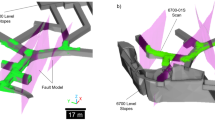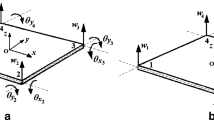Abstract
Geological surface modeling is typically based on seismic data, well data, and models of regional geology. However, structural interpretation of these data is error-prone, especially in the absence of structural morphology information, Existing geological surface models suffer from high levels of uncertainty, which exposes oil and gas exploration and development to additional risk. In this paper, we achieve a reconstruction of the uncertainties associated with a geological surface using chance-constrained programming based on multi-source data. We also quantified the uncertainty of the modeling data and added a disturbance term to the objective function. Finally, we verified the applicability of the method using both synthetic and real fault data. We found that the reconstructed geological models met geological rules and reduced the reconstruction uncertainty.
Similar content being viewed by others
References
Caers, J, 2011, Modeling uncertainty in the earth sciences: John Wiley & Sons, UK, 133–151.
Charnes, A., and Cooper, W. W., 1959, Chance-Constrained Programming: Management Science, 6(6), 73–79.
Cherpeau, N., Caumon, G., Caers, J., et al., 2012, Method for stochastic inverse modeling of fault geometry and connectivity using flow data: Mathematical Geosciences, 44(2), 147–168.
Cherpeau, N., and Caumon, G., 2015, Stochastic structural modelling in sparse data situations: Petroleum Geoscience, 21(4), 233–247.
dela Varga Miguel, and Wellmann, J. F., 2016, Structural geologic modeling as an inference problem: A Bayesian perspective: Interpretation, 4(3), 1–16.
Julio, C., and Caumon, G., 2013, Spatial constraints for the stochastic modeling of fault networks in the presence of large structural uncertainties: 75th EAGE Annual Conference & Exhibition incorporating SPE Europec.
Lecour, M., Cognot, R., Duvinage, I., et al., 2001, Modelling of stochastic faults and fault networks in a structural uncertainty study: Petroleum Geoscience, 7(S), S31–S42.
Liu, B., 1997, Dependent-chance programming: A class of stochastic optimization: Computers & Mathematics with Applications, 34(12), 89–104.
Mallet, J. L., 1992, Discrete smooth interpolation in geometric modelling: Computer-aided design, 24(4), 178–191.
Matheron, G., 1963, Principles of geostatistics: Economic geology, 58(8), 1246–1266.
Pakyuz-Charrier, E., Giraud, J., Lindsay, M., et al., 2018, Common Uncertainty Research Explorer Uncertainty Estimation in Geological 3D Modelling: AEGC, Sydney, Australia, 1–6. DOI: https://doi.org/10.1071/ASEG2018abW10_2D: https://www.researchgate.net/publication/323450843
Røe, P., Abrahamsen, P., Georgsen, F., et al., 2010, Flexible simulation of faults: 85th SPE Annual Technical Conference and Exhibition, Expanded Abstracts, 3604–3610.
Røe, P., Georgsen, F., and Abrahamsen, P., 2014, An uncertainty model for fault shape and location: Mathematical Geosciences, 46(8), 957–969.
Samson, P., Dubrule, O., and Euler, N., 1996, Quantifying the impact of structural uncertainties on gross-rock volume estimates: European 3-D Reservoir Modelling Conference, 381–392.
Thore, P., Shtuka, A., Lecour, M., et al., 2002, Structural uncertainties: Determination, management, and applications: Geophysics, 67(3), 840–852.
Acknowledgments
The authors are very grateful to the three reviewers for their critiques, helpful comments, and valuable suggestions which improved this manuscript significantly. The authors would like to thank Dr. Dennis K for the improvement of English language.
Author information
Authors and Affiliations
Corresponding author
Additional information
This work was supported by National Science and Technology Major Project(Grant No. 2017ZX05018004004) and the National Natural Science Foundation of China (No. U1562218 & 41604107).
Yu Shi-Cheng received his B.S. in Mathematics and Applied Mathematics form Chengdu University of Technology, Chengdu, China (2004) and his M. S. from the College of Information Science & Technology, Chengdu University of Technology, Chengdu, China (2009). He is a lecturer at the Engineering & Technical College of Chengdu University of Technology since 2010. Currently, he is a Ph.D. student in the School of Information and Communication Engineering, University of Electronic Science and Technology of China, Chengdu, China. His research interest are structural modeling.
Rights and permissions
About this article
Cite this article
Yu, SC., Lu, C. & Hu, GM. Reconstruction of geological surfaces using chance-constrained programming. Appl. Geophys. 16, 125–136 (2019). https://doi.org/10.1007/s11770-019-0744-7
Received:
Revised:
Published:
Issue Date:
DOI: https://doi.org/10.1007/s11770-019-0744-7




